Last Updated on February 25, 2025 by Owen McGab Enaohwo

Have you tried ProcessKit and found that it does not meet your requirements? Now you’re looking for a tool that’s faster, simpler, and less expensive than ProcessKit.
You’re not alone.
There are many like you who tried ProcessKit and were dissatisfied with it. Then they came across SweetProcess, where their search ended and their businesses changed.
Keep reading to see why SweetProcess is the preferred process management tool for most businesses and organizations.
First, a general overview of both solutions.
Note: Experience still remains the best teacher. Your search for a process management solution will only end when you’ve tried the best in the market. And that’s why we’ve provided an opportunity for you to try SweetProcess for free for 14 days without even using a credit card. We are that confident. Click here to start your free trial now.
Table of Contents
Chapter 1: ProcessKit vs. SweetProcess: Overview
Chapter 2: ProcessKit vs. SweetProcess: Documenting Processes
Chapter 3: ProcessKit vs. SweetProcess: Documenting Standard Operating Procedures (SOPs)
Chapter 4: ProcessKit vs. SweetProcess: Documenting Policies
Chapter 5: Why Organizations Choose SweetProcess Over ProcessKit
Chapter 1: ProcessKit vs. SweetProcess: Overview

Before we dive deep into which process management software you should use, here is a general overview of both systems to help you reach a quick decision.
What is ProcessKit?

ProcessKit is a project management tool designed to help you streamline your processes and keep track of their progress. It is integratable with Zapier, a third-party integration and automated workflow tool, and provides ready-made templates upon registration.
ProcessKit may not fare poorly as a process management system, but today’s fast-growing businesses require a process management tool that performs better than “not poor.” They require a tool that satisfies all of their requirements, allowing them to devote more time to other aspects of business management.
ProcessKit, like nearly every other process management tool in the market today, offers these features:
- Business process automation, allowing you to automate your business processes
- Business process control
- Access and permission control for admins
- Third-party integration
- Project planning
- Management
No matter how basic, these are features that every process management tool must possess.
The cons of using ProcessKit, some of which you already know if you have tried this software, include issues with the user interface. The software is not exactly easy to use for beginners, and requires time to get familiar. Some users complain that setting it up takes a while and that while the software itself might be easy to use, understanding how it works and building processes within it can be a challenge.
Businesses with complex procedures that use ProcessKit are met with a confusing, inefficient system that they must spend valuable time learning and navigating.
In a different yet similar review, another user shares that they encountered the same problems. Having trouble building processes is apparently a common problem for first-time users of ProcessKit.
Besides the issue of a non-friendly user interface, there are bigger issues to using ProcessKit. For example, a good process management tool should provide you a timeline of your projects, processes, or ideas. Without a way to track progress, businesses using ProcessKit operate almost blindly, having to manually keep track of how much has been done and how far the process has progressed.
Now let’s look at SweetProcess.
What is SweetProcess?
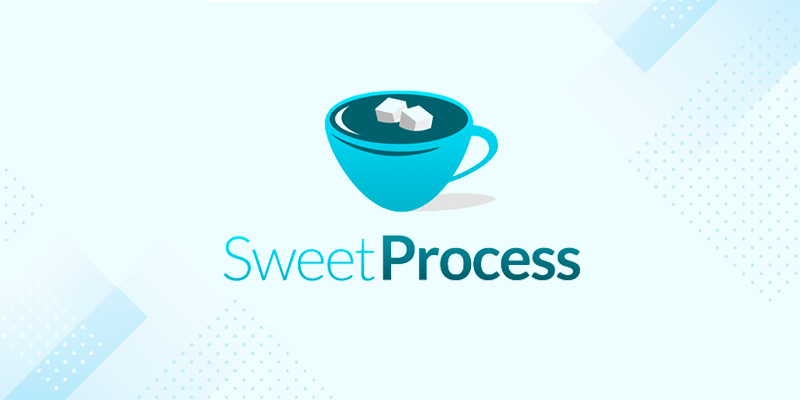
SweetProcess is an SaaS solution for mid-sized, enterprise, and multinational businesses that makes documenting standard operating procedures (SOPs) and sharing procedures with a team simple and efficient.
SweetProcess offers an easy-to-use interface for everyone, and offers a means to keep track of your processes and procedures so you can be sure of how much progress has been achieved.
SweetProcess offers many helpful features to help organizations scale their businesses. With SweetProcess, you can automate business processes, allowing for intuitive working where your standard operating procedures are automatically carried out.
You can also manage the workflow within the company, assigning and reassigning tasks as they pass each desk, adding tasks, marking tasks as completed, etc.
SweetProcess includes features such as standard operating procedures documentation, which is designed to train new workers on established processes.
To make managing your processes easier, SweetProcees also:
- Displays all process tasks in a checklist format
- Deploys videos and images to help explain tasks
- Tracks all progress as a worker goes through a process
- Includes a mobile device user interface
- Identifies ways to streamline processes
- Enables file attachments
- Allows for comments and collaboration, drafts and approvals
- Allows you to assign and track tasks
- Allows you to audit trails with Excel, Word and PDF procedure export
- Provides two-factor authentication
- Provides email and phone support
- And more!
A real-life example of SweetProcess in action is seen in Benchmark Wealth Management’s case study.
Benchmark Wealth Management

Rather than a “one-size-fits-all” investment model, the Benchmark Wealth Management team provides customized services to answer customers’ specific financial questions.
In order to maximize its opportunities for growth, the team looked for a software program to record its processes. They then discovered SweetProcess.
“Our situation was a big question mark hanging over our head for a couple of years. We knew our processes in our heads and we would communicate them one by one. Every time we brought somebody new on board, we repeated ourselves a lot, and then, of course, if one person did it differently than the next person, we started running into issues,” says Sarah Beach, branch operations manager at Benchmark Wealth Management.
“We were struggling with processes. We did some searching on our own and stumbled on SweetProcess. It was a great stumble for us, and we really fell into it.”
They signed up for SweetProcess’ 14-day free trial and they have been on board since then.
With SweetProcess, they have streamlined their processes, including employee onboarding, process documenting, and employee independence. These have led to not just growth, but purposeful growth.
You can read the full Benchmark Wealth Management case study here.
Another company that has seen great progress after signing on with SweetProcess is Synergy Billing. Megan Tully, director of business process management, says this about using SweetProcess: “SweetProcess is not only cost effective, but it gives you the ability to scale your business and grow. It gives you the tools and resources to grow.”
ProcessKit vs. SweetProcess at a Glance
Now that you know what both pieces of software are, let’s take a look at how they compare against each other. Firstly, at a glance:
| Features | ProcessKit | SweetProcess |
| Pricing | $49/month for 3 members; $19/added member | $99/month for 20 members; $5/added member |
| Operating System | Web, Saas, Cloud | Web, Saas, Cloud |
| Users | Companies, businesses, organizations, etc. | Companies, content creators, businesses, organizations |
| Customer Support | Chat | Email, Phone call |
| Training Material | Videos, documentation | Documentation |
| Deployment | PC | PC, mobile, tablet |
| Screen Printing | No | Yes |
Now that you have a general overview of ProcessKit and SweetProcess, next is a head-to-head comparison to see how they fare against each other specifically in the areas of documenting SOPs, processes, and policies respectively.
From the comparison table alone, you can already tell that SweetProcess is the superior software among both products. Click here to try SweetProcess out for free for 14 days; you won’t even need to input a credit or debit card.
Chapter 2: ProcessKit vs. SweetProcess: Documenting Processes

An important aspect of all process management tools is documenting processes. How do these two score individually and against each other?
ProcessKit

To document your process on ProcessKit, you can either use one of their premade templates or build from scratch.
Like SweetProcess and other process management tools, you can add steps, name steps, add external files as needed, reorder and delete steps until you’re satisfied with your process.
Managing your processes and all the tasks that make them up on ProcessKit cannot be done in real-time. Uploading new tasks to a process does not reflect immediately.
Step-by-step instructions on creating processes in ProcessKit
- If you don’t have a process yet, then you can immediately start creating one as soon as you log in to your account, either by selecting a template kit or building from scratch. Otherwise, click on the “Processes” menu by the left side of the screen.
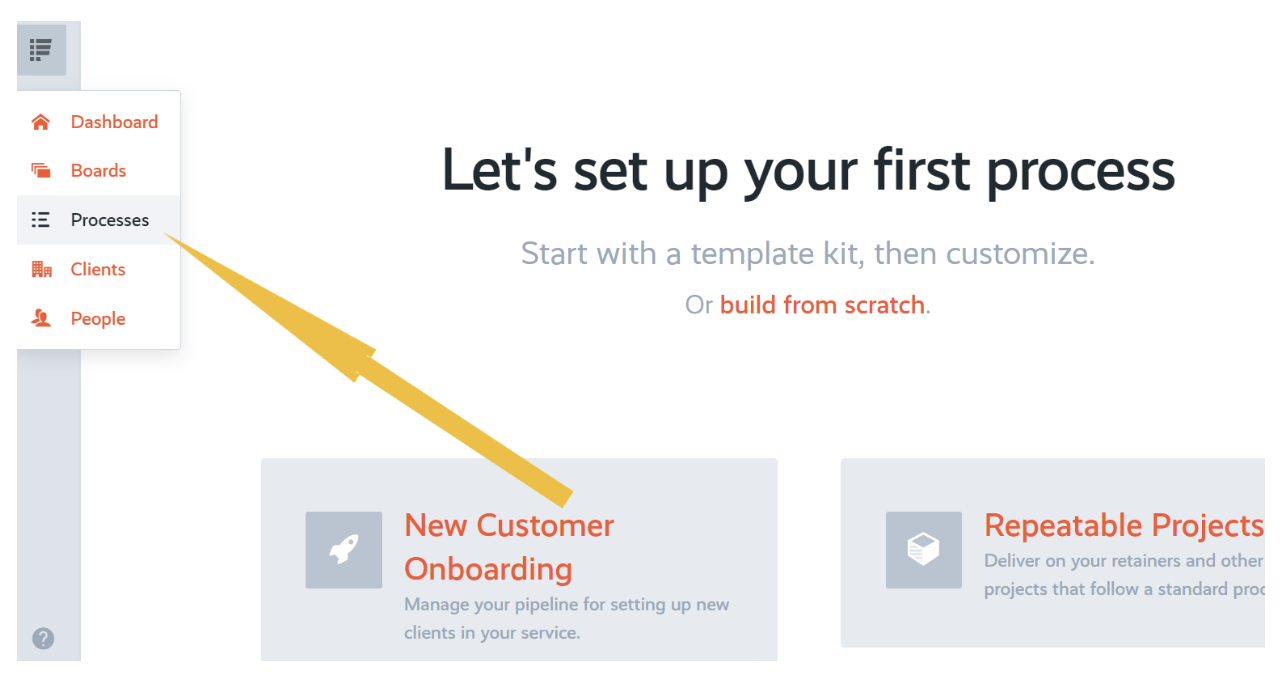
- Select “Create a process.”

- Add a title to the process and click on “Create Process.”

- The process editor opens, and here you can add a step to the process by first adding a “Step Title” and then either click “Save & add another” to add another step or click the dropdown and select “Save & finish.”

- You can later add content to each step by hovering over it and clicking “Open” or clicking the dropdown menu and clicking “Open.”

- From the same dropdown, you can “Propagate changes” to your process and it gets published and sent to those concerned.

This is how to create a process in ProcessKit. As you can see, there is no step for adding decisions and some other necessary components of a process.
Let us consider SweetProcess next.
SweetProcess

When creating a process with SweetProcess, the software gently carries you along. It is a smooth experience, fully augmented with texts and visuals.
You can document all kinds of processes on SweetProcess without fear of needing to oversee them being carried out by your team members or employees.
Assign tasks to team members within the process and get real-time updates.
With SweetProcess, managing your clients’ information is much easier. It is a smooth process where everyone can correspond and collaborate within the process you have created, removing the need for any other software for communication or collaboration on processes, both between your team members and between you and your clients.

You can assign specific teams or sub-teams to each process, which allows you to know exactly who is supposed to do what, and whether they are doing it.
Here is a step by step instruction on how to create processes on SweetProcess
The instructions below will show you how to create a new process.
1. Click on the “Processes” tab from your SweetProcess account.
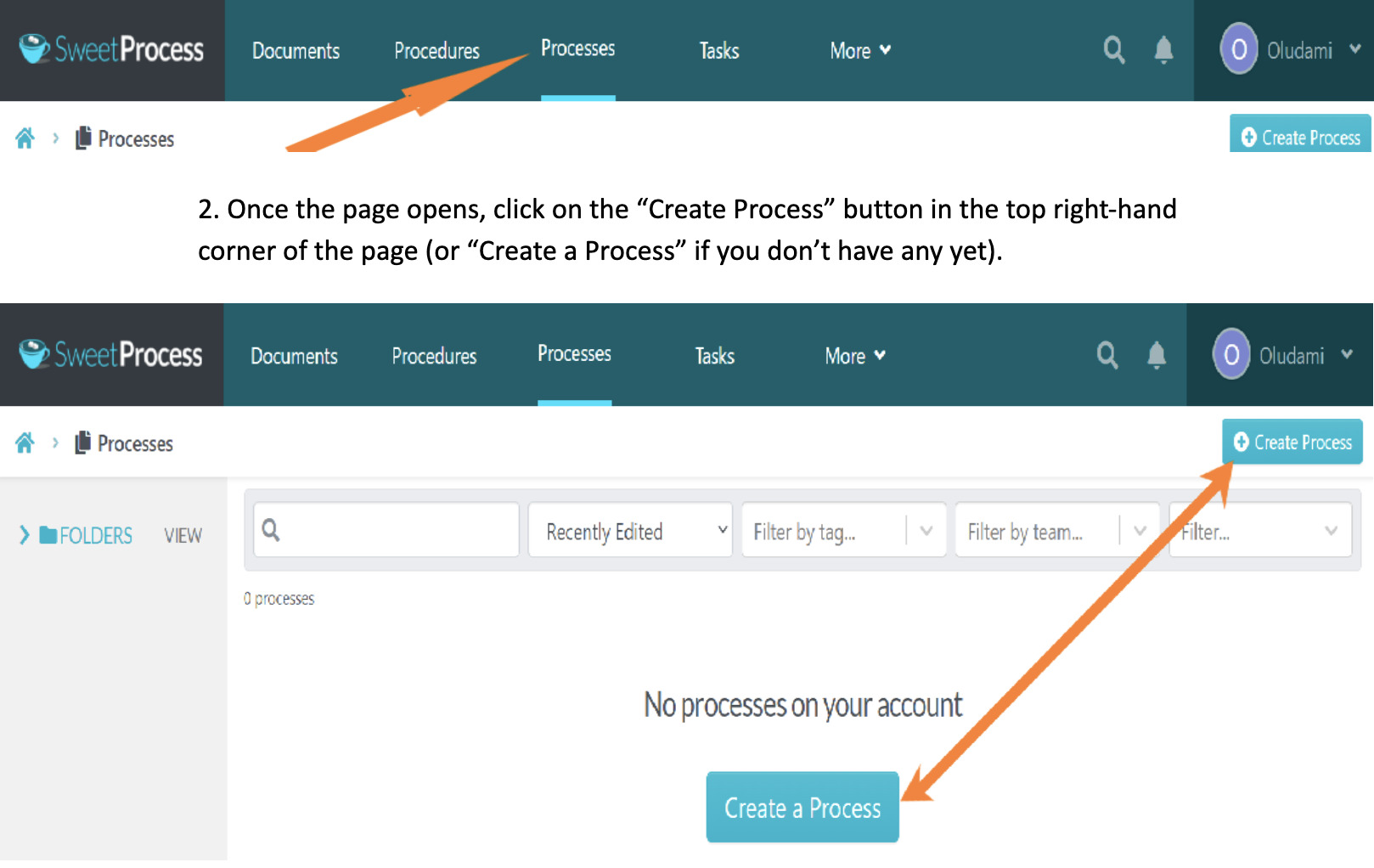
3. Enter the title of the process.

4. Click on a checkbox to add the process to a team or on multiple checkboxes to add the process to multiple teams at the same time. (If you don’t have a team yet, you’ll be able to create a team once you click on the “Add to teams” dropdown.)

5. Click on the title of the process to add a description.

6. Click on the “Continue” button.

7. You’ll be taken to the editing page. Simply click on “Add Step” to start adding the steps in your process.

8. An editor will open up where you can input text, image, video, link, etc. You can also add tags at this stage. Once you’re done editing and satisfied, click on “Finished editing.”
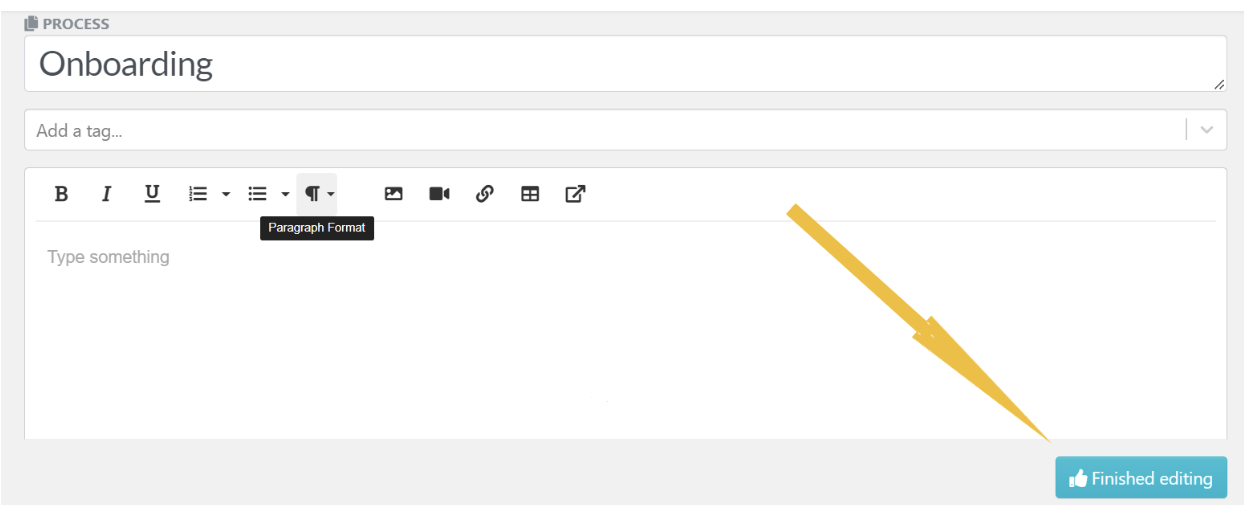
9. Repeat until satisfied.
10. Add an end step.
11. Save the draft and review as you want.
12. Don’t forget to approve your draft when you’re all done. That’s when it goes live.

And now you have a brand-new process!
Below is a case study of how using SweetProcess has helped Atlantic Sapphire in their business.
How Documenting Its Business Processes Helped Atlantic Sapphire Transfer Operational Knowledge Between Facilities

Atlantic Sapphire is a company that raises salmon. To avoid harmful exposure to ocean creatures and water pollution, the traditional method of farming salmon in the oceans has given way to land-based salmon farming.
Atlantic Sapphire, which was founded in 2010, is opposed to environmental pollution caused by the continuous air transportation of salmon in non-sustainable packaging from one country to another, including the United States. It grows the fish at its facilities in Denmark and the United States and distributes them by road rather than air.
Transferring knowledge was also difficult. The firm already had a presence in Denmark. There was a need to transfer operational knowledge to employees at its new US facility for collaboration and quality assurance.
In an effort to rectify this problem, Stanley Kolososkiy, process and development manager at Atlantic Sapphire, tried out several software before he finally settled for SweetProcess.
“I found a lot of the software funky. I went on a research spree to find what we could use and then I found SweetProcess. It was the most intuitive software that I found that basically anybody can use.”
The result? A business with properly managed processes. Streamlined business process documentation, seamless employee onboarding and training, decentralized knowledge base, and more are the benefits that Atlantic Sapphire reaped from using SweetProcess, a very easy to use software.
“It’s very powerful but it’s also easy enough for somebody to get up and running. Probably in a 20-minute session, they know the basics.”
SweetProcess can help you achieve your business goals by streamlining your operations. Sign up today for a 14-day free trial.
You can also click here to find Atlantic Sapphire’s full case study.
Procedures and processes are not all there is to properly managing a business. Policy management is another important aspect of business processes management tools. This is what we will discuss next.
Chapter 3: ProcessKit vs. SweetProcess: Documenting Standard Operating Procedures (SOPs)

How do ProcessKit and SweetProcess perform in documenting standard operating procedures?
ProcessKit

As previously stated, ProcessKit allows you to manage standard operating procedures, such as client or employee onboarding.
The process on ProcessKit is simple enough, but the lack of mobile deployment means that employees and team members cannot work from anywhere. This poses a problem. Sometimes employees and team members need to accomplish tasks immediately, but due to ProcessKit’s non-compatibility with mobile devices, they have to wait until much later.
More so, when you want to document new standard operating procedures on ProcessKit, it requires more time and effort than necessary due to the customization required to get things going on the software.
Another big con of this software is that there isn’t a separate option for creating procedures. On ProcessKit, procedures go under the same section as processes as well as policies.
In essence, if you’d like to create procedures on ProcessKit, simply follow the steps under the “Processes” chapter above.
SweetProcess
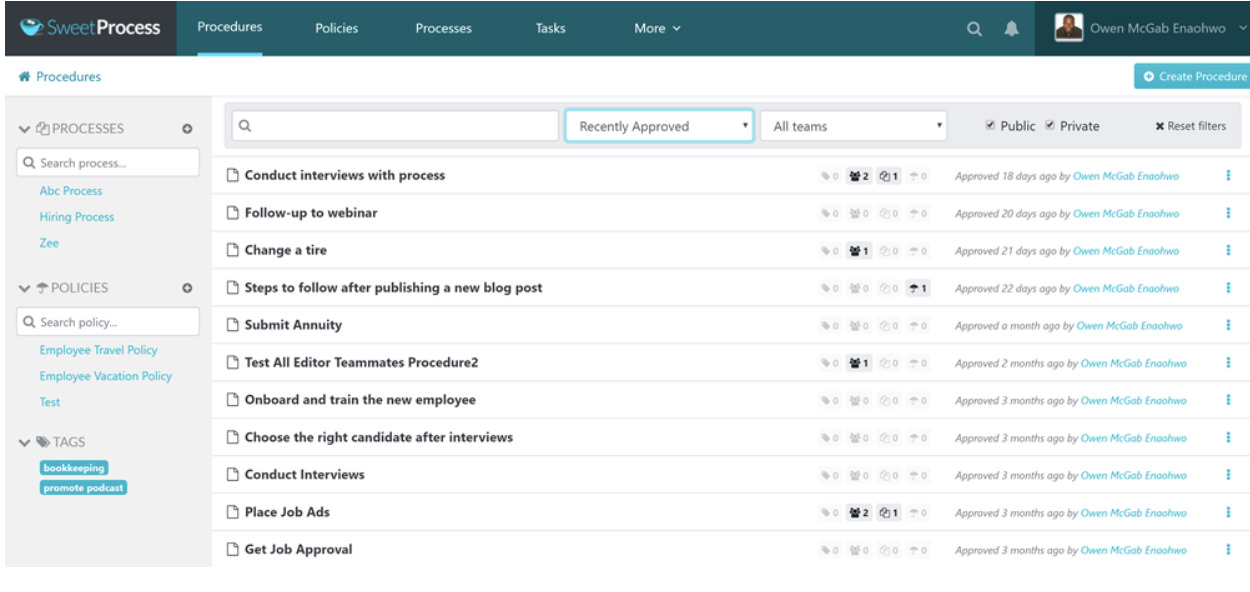
On SweetProcess, the interface is much easier. Existing SOPs are automatically activated once you click on them, notifying every team member involved in an instant. Changes made to the task are automatically updated.
Also, SweetProcess allows you to track, in real time, the progress of every team member on your standard operating procedure, something that can be easily done on the much-easier-to-use-and-understand software.
The deployment options, PC, mobile or tablet, allow for flexibility and real-time progress: when your team members can work, whether on the field, in their homes or in the office, things get done much faster.
To help make it easier for your team members and employees to understand the task you have created, you can also import external files. Creating your SOPs on SweetProcess will help you free up more time to focus on other things, like growing your company. You’ll be able to manage your standard operating procedures and work instructions without getting physically involved.
Below is a step-by-step tutorial with screenshots that shows how easy it is to create a procedure on SweetProcess.
Step-by-Step: How to Create a Procedure on SweetProcess
Here’s a quick walk-through of how to create a procedure on SweetProcess.
1. Log in to your SweetProcess account and click on the “Procedures” tab.

2. Next, click on the “Create Procedure” button.

3. Add a title to your procedure. This will make finding it later easy.

4. Add the procedure to your team, or multiple teams.

5. Click on the “Continue” button to continue creating your procedure.

6. Add a description to your process to further explain it.
7. By making use of a tag, you will be assigning an index keyword/phrase/term to a procedure so that it can be quickly identified.

8. Add a step to your process to begin.

9. Add title and description to the step.

10. Do you have images? Add them too. You can even add videos, links, etc.

11. Save the draft by clicking on “Finished Editing”.

12. Click on “Add a Step” to add a new step.
13. Repeat 7, 8, 9, 10 and 11 until all the steps are added.
14. Are you finished? Approve it.

15. And if you don’t have that permission or authority, request approval.

16. You’re all set. To check out your procedures, just click on the “Procedures” tab.

Are you wondering what effect this will have on your business or organization? Below is a case study that will give you an idea.
How Turkstra Lumber Increased Employee Productivity by Developing Smooth Business Procedures

Jamie Ramsden, Turkstra Lumber’s business intelligence and lean Six Sigma champion, places a high priority on maintaining the effectiveness of the company’s operations.
Jamie and his team were up to the task in terms of job expertise. However, because they worked in a field where processes weren’t “leading edge,” they had to rely entirely on themselves to complete tasks. Despite the fact that business was doing well, they understood that they could improve with more efficient business practices.
The team began studying the lean concept in an effort to improve their processes. They went a step further and used Excel sheets to document their procedures, but the outcomes fell far short of what they required.
Interestingly, Jamie was initially hesitant to use SweetProcess because he perceived the system to be difficult to use. But he quickly realized that SweetProcess was as simple as they come.
Using SweetProcess was a game changer as it was easy for all the team members to understand the very friendly interface.
“The thing that caught my attention first was just something simple and visual, which is that SweetProcess automatically makes you a little flowchart as you enter your steps for any process. People understand things in different ways and a lot of our staff really like that if they can get a visual representation immediately,” says Jamie.
Documenting their standard operating procedures became much easier from then onward. They had a centralized knowledge base which increased employee efficiency and team collaboration.
The organization’s adoption of SweetProcess was a watershed moment. It was not only able to streamline its processes for smooth operations, but it was also able to groom more competent employees. You can do the same by signing up for SweetProcess’ 14-day free trial here. There is no need for a credit card.
You can read the full Turkstra Lumber case study here.
We have seen how they both perform in documenting standard operating procedures, and, obviously, the clear winner is SweetProcess.
Next let’s look at how they both perform in documenting policies.
Chapter 4: ProcessKit vs. SweetProcess: Documenting Policies

ProcessKit

Just as you’ve read in the section about procedures, to document your policies on ProcessKit you will have to document it as a process. The software does not provide separate options for procedures or policies.
When all your procedures and policies are documented as processes, there is bound to be confusion in policy management. The time and energy spent differentiating between the three and putting them in their place could be put to better use.
Since the steps to create your policy are the same as those in creating your processes, we won’t bother repeating those steps here in this section. You can check them out under the “Processes” chapter.
SweetProcess
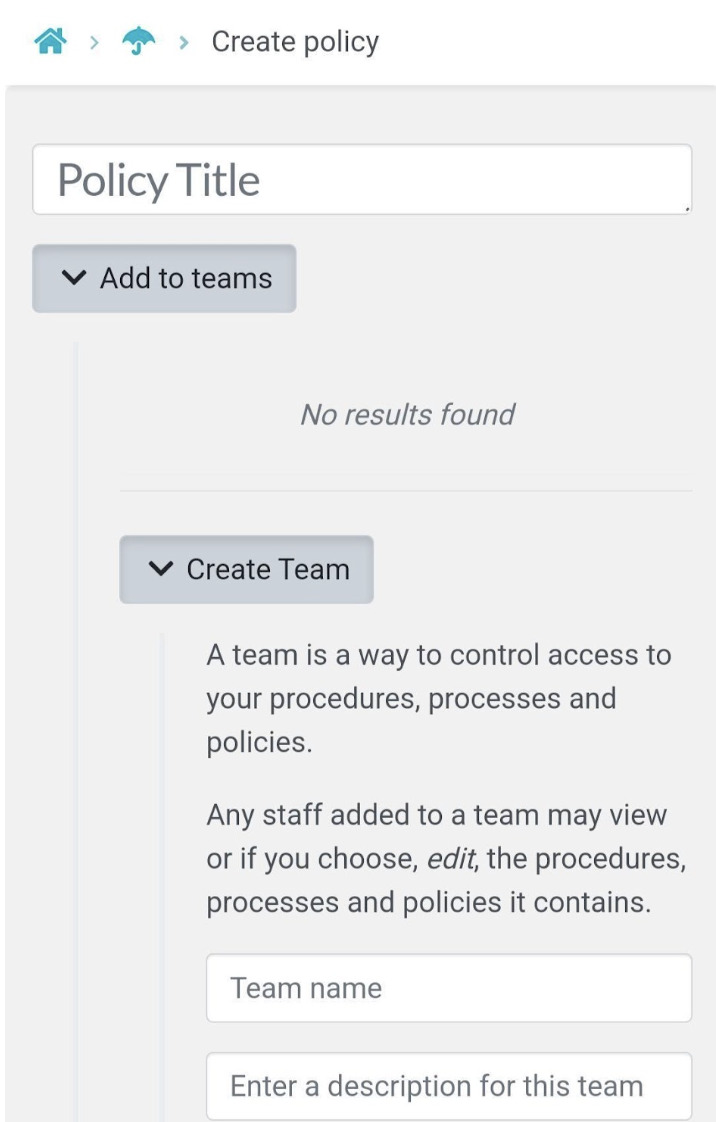
SweetProcess understands that policies, procedures, and processes are very distinct and should be easily distinguishable from each other. Hence, SweetProcess allows you to create policies separate from processes and procedures.
The steps, however, do not differ too much, thus creating a familiarity with the software that ProcessKit does not offer. This way, processes, procedures, and policies are created separately but in the same fashion—and live in their own separate homes. Once you know how to create one, you can create the others.
This is one of the reasons customers always describe SweetProcess as easy to use—customers like Stone & Wood, who by creating their policies on SweetProcess, brought structure to their operations.
Step-by-Step: How to Create Policies On SweetProcess
This is a step-by-step demo of how to create policies on SweetProcess, with screenshots. This example was done on mobile, just to show you how easy it is to use SweetProcess across devices.
- From the drop down, select “Policies.”

- On the next page, give a title to your policy.

- Then select the team(s) that this policy concerns.
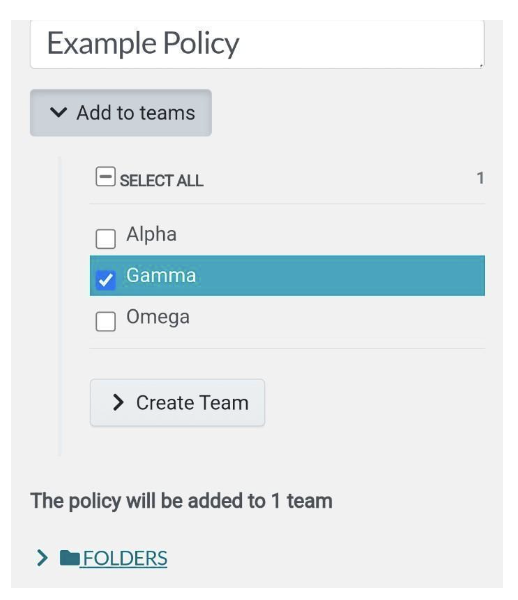
- Add folder(s), if they are needed, to the policy.

- On the next page, you’ll fill in the content of the policy. As you can see, there are options for proper formatting, including pictures, videos, links, and tables.

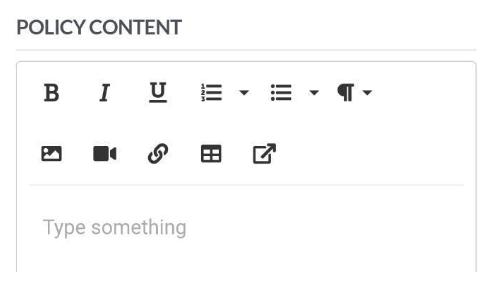
- If needed, embed a video or attach a file to your new policy document.

- Repeat 4, 5, 6 as necessary.
- Save your policy draft.

- And finally, review and approve the policy.
The next section will help you learn how to approve policies, procedures, processes, etc. on SweetProcess.
How to Approve Procedures, Policies, and Processes on SweetProcess
When a draft of a procedure is approved, it becomes the live version. This allows the content to be searchable.
Note: Only managers of teams and super managers have the ability to approve drafts of procedures.
- Click on the procedure you want to view.
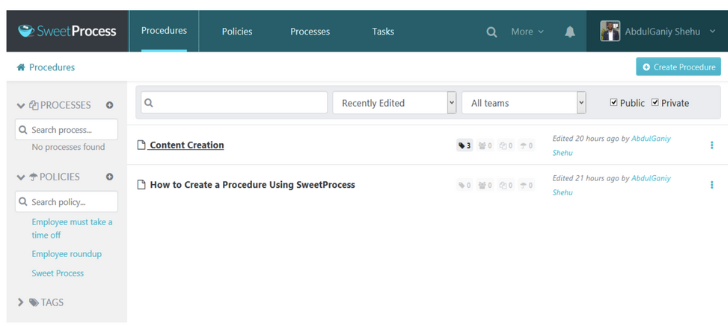
- When the procedure page loads, click on the clock icon.

- When the versions history sidebar for the procedure opens, click on the draft of the procedure you want to approve.
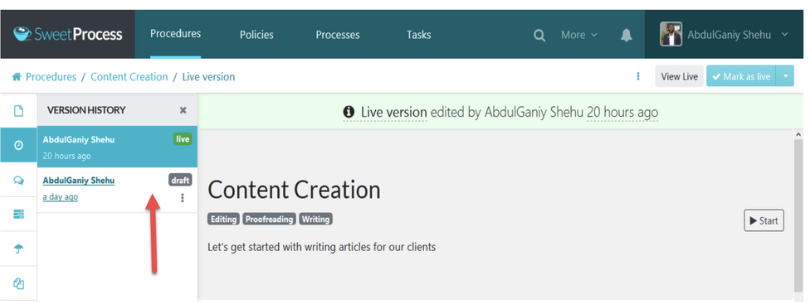
- Click on the “Approve & Notify” button to make the draft of the procedure goes live, and notify everyone who has access to it.
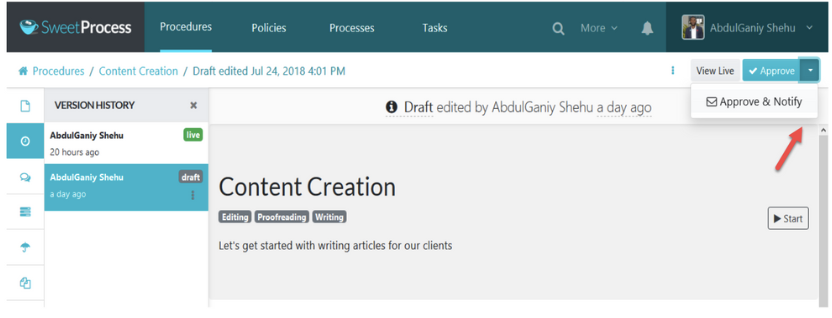
How about a quick case study to help you see the effects of creating policies in SweetProcess?
How Stone & Wood Improved Business Performance by Restructuring Its Operations
Stone & Wood is a brewing company that produces quality beer from its home in the Northern Rivers region of Australia.
Thomas Parker’s responsibilities as the quality assurance and sensory coordinator at Stone & Wood revolve around maintaining quality assurance and smooth operations.
Maintaining quality assurance has always been a top priority for the organization. Aside from maintaining consistency in the taste of its beer, it must adhere to the regulatory standards in its industry or risk being sanctioned. However, working with binders and Microsoft Word to document their processes was far from ideal.
Thomas resolved that they needed a better way to the standard policies and their procedures, and was determined to get the easiest to use for his team.
Using SweetProcess helped Stone & Wood stay in touch with policies.
“It really helps us a lot with standard requirements that are out there like the International Organization for Standardization (ISO) where you have to demonstrate that your employees have been trained and show procedure documents, so it ticks all the boxes there,” Thomas says.
Stone & Wood was able to improve its human resources and strengthen its operations by simply adopting SweetProcess.
If you want to try SweetProcess now, you can begin by signing up for a 14-day free trial without needing a credit card.
To read the full Stone & Wood case study, click here.
Now that you’ve seen how SweetProcess fares better in comparison to ProcessKit, in terms of creating processes, SOPs and policies, it might help to understand why other organizations like yours choose SweetProcess over the competition.
Chapter 5: Why Organizations Choose SweetProcess Over ProcessKit

You are now aware that SweetProcess outperforms ProcessKit and other similar tools at this point. But why have over 40,000 businesses chosen SweetProcess over ProcessKit, and why have they all decided to stay with SweetProcess ever since?
The answer is simple: when it comes to documenting your processes, procedures, and policies, SweetProcess outperforms the competition. It has no match in the industry.
We are not saying this out of bias; in fact don’t take our word for it. You’ve seen the features available to you as a SweetProcess user, but you should also hear from a few businesses as to why they chose SweetProcess over the competition.
In this video interview, Gretchen Pisano and Jennifer Schneider of pLink Leadership talk about how they used SweetProcess to eliminate fear among employees with a strong knowledge base.
“We just found it to be really terrific and doing exactly what we needed it to do, which was provide an easy place for people with a robust search function. We have several members of our team who are afraid they’re gonna mess something up but you just give them the instruction. It gives people the opportunity to be self-sufficient.”
In another interview, Emma Mills of MiPA speaks on how much her business has come to rely on SweetProcess. She says, “It pretty much directs and helps our team get 90% done of any task. It’s a massive part, the backbone of our business.”
Here’s a case study of how Neave Group Outdoor Solutions increased their effectiveness and doubled their size by documenting and implementing better systems.

Neave Group Outdoor Solutions has 125 full-time employees and operates on both a B2C and B2B basis. They design spaces for people to enjoy and entertain in, use for parties, and elevate their clients’ lifestyles.
They provide landscape maintenance, snow removal, and holiday decorating for commercial clients. They also ensure the safety of the lots.
They provide high-end construction and maintenance services for residential clients, such as the installation of backyard swimming pools, patios, fire pits, decks, outdoor structure, lighting, and event planting.
The Problem
Scott Neave is the CEO of Neave Group Outdoor Solutions and is in charge of the company’s operations and ensuring that everything runs smoothly at all levels. Scott’s executive assistant is Susan Thompson.
They initially struggled with being too detailed when developing systems. Before coming onboard SweetProcess, Scott’s workday was not very ordered.
SweetProcess, The Solution

Scott said though he stumbled upon SweetProcess, it was a timely discovery.
The Result
Susan appreciates how easy it is to search and reference their processes and procedures at any time, allowing them to train more efficiently and hold their team accountable to tasks.
“One of the best things about SweetProcess is the searchability and you can access it on all your devices,” she says.
Scott adds that, “Continual improvement is important to me as a CEO and company. With our systems in place, we can easily find bottlenecks. We can revert to past working versions of processes. We can make current systems better. So, the power is in the ability to constantly improve the business.”
Scott and Susan are now capable of leading a 125-person organization with a plethora of challenges, requirements, customers, and job sites.
Click here to find the full Neave Group case study.
Here’s how Simple Solutions reduced the costs of frequent errors while improving service quality.

Simple Solutions is led by CEO Alejandro Céspedes. He is in charge of the company’s marketing and sales, as well as administrative tasks. Simple Solutions is a B2B consulting firm that helps clients in manufacturing, retail, and distribution improve their production and inventory management planning and scheduling processes.
The Problem
No one in the company had any documentation related to their work at first. This frequently meant that finishing any task took a long time because everyone had their own way of doing things. Inefficiencies extended to having to redo work due to errors.
Alejandro, for example, recalls that his assistant was constantly coming to him with the same questions. And, despite his best efforts to assist her, she kept making mistakes and had to redo tasks.
Alejandro used his own time and energy to create videos for his assistant detailing how to complete various tasks, including how to prepare invoices, in an effort to build a long-term solution.
He also began documenting client-handling processes, but his team was not disciplined in implementing them because they did not have processes for every task. These were only temporary fixes that did not last. These solutions were not simple.
SweetProcess, The Solution
Carlos Sierra, technical manager, began researching various tools on the internet. He had the team look at several options after narrowing them down. They had set criteria for evaluating apps, such as ease of use, sharing, editing, and customization.
SweetProcess emerged as the clear winner after evaluating each tool.
Although Alejandro was not skeptical of SweetProcess, he was aware that the company would require guidelines for standardizing procedures and involving the entire team. Getting his team’s buy-in was initially difficult because everyone had their own way of doing things.
Simple Solutions now recognizes the value of SweetProcess and uses it extensively. Many procedures are now documented at the company. In the beginning, Alejandro set a goal of documenting one procedure per week. So far, he’s been able to document multiple times a week.
The Result
Alejandro feels more at ease now when delegating to employees. All they have to do is follow the existing process.

Even clients know exactly what to do too, thanks to SweetProcess!

You can read the full Simple Solutions case study here.
What’s Next?
Since its inception, SweetProcess has been helping organizations, businesses, and companies simplify their business process management. And they’re all the better for it.
Companies have increased their capacity, streamlined their processes and kept track of policies, thereby scaling and growing their businesses with SweetProcess by their side.
Try it for yourself. Sign up for a trial period of 14 days, without a credit card, here.
Chapter 6: Conclusion

What all the testimonials and reviews you have read show is that when compared to ProcessKit, and other options available, it is clear that, as a process management tool, SweetProcess meets every kind of need. It delivers on the basics, the essentials, and the particular needs of every business and organization.
Dr. Richard A. Rasmussen Jr., DSS, owner and president of Implant and Periodontal Therapy, puts it simply: “SweetProcess is basically a very standardized, online, true operational manual for any kind of a business.”
Luckily, you can try SweetProcess for free by signing up for the free 14-day trial—you don’t even need your credit card to do that. All you have to do is click this link to get started.
You simply can’t get a sweeter deal than this anywhere.
